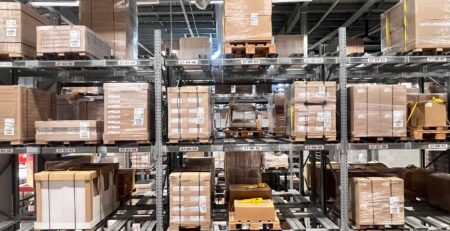You’ve seen it a hundred times: that $10-$15 shipping charge on your online order from a local Sydney shop. Maybe you’ve wondered why they can’t just charge the exact postage price, or why some stores have minimum spend requirements for free shipping. The truth is, there’s a whole iceberg of costs beneath that seemingly simple shipping fee – and most customers never see the full picture.
In this post, we’ll pull back the curtain on what Sydney shop owners really face when shipping Australia-wide. You’ll learn:
- How Australia’s size and distance reshape delivery timeframes and costs
- The true expenses that never appear on a postage label of ecommerce shipping in Australia
- How speed expectations impact freight management, logistics and operational costs
- The most common (and often unavoidable) causes of shipping delays
- How professional freight partners offer competitive interstate freight quote and help Sydney businesses keep their promises
Australia’s Distance Problem – How It Creates Unique Shipping Challenges
Australia behaves like a continent, not just a country. This fundamental reality shapes every aspect of domestic shipping and creates costs that customers in smaller countries never encounter.
Geographic Realities Drive Pricing Differences
Sydney to Melbourne is a short, busy lane with multiple daily services and competitive pricing. But Sydney to Perth? It represents a completely different proposition – longer linehaul distances, fewer service options, and more network hand-offs. The same product in identical packaging faces vastly different transit times and costs depending on its destination.
Courier companies charge by weight, size, and critically, distance. A parcel might cost significantly less to send between nearby major cities compared to remote destinations. Regional areas often face premium rates that can be double or triple metropolitan costs. This isn’t carrier greed – it’s the economic reality of moving goods across one of the world’s largest countries.
Transit Time Variations Customers Don’t Expect
Distance directly impacts delivery speed (and freight costs) in ways that surprise many buyers:
- Major city routes: Often 1-3 business days on standard services
- Interstate destinations: Typically 2-5 business days
- Remote areas: Can extend to a week or more
Yet customers often expect uniform delivery times regardless of destination. When a Sydney business quotes different timeframes for various locations, they’re not being difficult – they’re being honest about geography and logistics involved.
Why Premium Speed Costs Significantly More
Express services command higher prices because they require priority space on earlier transport, faster processing, tighter tracking protocols, and often completely different carrier networks. You’re not just paying for speed but for operational complexity and guaranteed capacity.
The Real Costs Beyond the Postage Label
Sydney shop owners manage a complex web of expenses that buyers rarely consider. Here’s some details to help you decode the shipping cost better:
Packaging Materials Represent Major Ongoing Freight Costs
Every safe delivery starts with proper materials like sturdy carton boxes, padded mailers, protective wraps, void fill etc. A small business can easily spend hundreds of dollars monthly on packaging materials alone, depending on order volume and product types.
In addition, shipping fragile items require custom protection solutions that cost more and take longer to prepare. Cutting corners here saves pennies but risks expensive claims, replacements, and negative reviews – costs that small businesses simply can’t afford.
Equipment and Technology Infrastructure
Behind every shipping label lies infrastructure investment – Think thermal printers and replacement components, shipping softwares and tracking systems, label stock, ink cartridges and other maintenance supplies. These tools are essential for accurate, compliant shipping but represent pure overhead that never appears on customer invoices.
Increasing Labour Costs
“Pack and send” sounds so easy – until you map the actual process.
Staff must confirm order contents, select appropriate packaging, secure fragile items properly, weigh and measure for pricing compliance, print and apply labels, book courier pickups, and meet depot cut-off times. Even with well-structured and streamlined processes, orders can require anywhere from 10 to 30 minutes of skilled labour depending on complexity. At Australia’s wage rates, this represents several dollars in direct costs before considering the business owner’s time in training, troubleshooting, and managing exceptions.
Why Stores Mark Shipping Up (Even When They Don’t Want To)
If a shop charged only the raw courier label price, it would absorb packaging costs, equipment expenses, labour time, returns processing, payment gateway fees on shipping charges, and occasional reshipping after carrier errors. That math doesn’t work. Sustainable Sydney retailers typically use one of three approaches:
Flat-Rate Shipping: Offers predictability for both parties. A retailer might charge a set amount Australia-wide, knowing this covers costs for most destinations while remaining competitive. The business loses slightly on distant deliveries but enjoys better margins on nearby orders. Customers appreciate the simplicity and avoid cart abandonment at the shipping step.
Free Shipping with Minimum Spend: This has become increasingly popular because order margins can absorb delivery costs on larger purchases. This approach encourages higher basket values while giving buyers control: pay shipping on small orders or add items to qualify for free delivery.
Built-In Shipping Margin: This approach involves incorporating delivery costs into product pricing, allowing visible shipping charges to stay low or disappear entirely. Customers feel they’re getting value while businesses avoid subsidising delivery on every transaction.
These strategies represent different approaches to covering the genuine cost of safe, on-time delivery without turning every checkout into a complex cost calculation. Smart retailers choose the model that best matches their customer base and product mix while ensuring long-term sustainability.
Why Delivery Speed Matters Almost as Much as Price
Speed Becomes a Competitive Differentiator
Customer reviews increasingly mention delivery speed, with late arrivals triggering negative feedback regardless of product quality or competitive shipping prices. A Sydney retailer might offer competitive shipping rates, but consistent delays can damage their reputation and long-term sales potential.
On-time delivery reduces order-tracking related support tickets, protects online ratings, and reduces returns from impatient customers.
The Pressure of Fast Delivery Expectations
Same-day and next-day delivery expectations create operational pressure that many small businesses struggle to meet. Success often requires partnerships with different carriers optimised for various routes and service levels. Different lanes might work best with different providers depending on their network strengths.
Offering express shipping services is also a viable option, but it can cost significantly more than standard delivery, but businesses unable to offer these options risk losing customers to competitors who can. Further, meeting tight delivery promises requires earlier cut-off times for same-day dispatch, streamlined packing processes, and backup plans when primary carriers face delays.
Balancing Customer Expectations with Business Reality
Today, customer expectations have shifted. Progressive Sydney retailers now offer tiered shipping options: standard delivery at competitive rates alongside express services for time-sensitive orders. This approach satisfies price-conscious buyers while accommodating customers who prefer speed and will pay for it.
Common Causes of Parcel Delays Even When Providers Do Everything Right
When it comes to parcel shipping in Australia, certain variables remain outside both merchant and carrier control. Here’s why the shipping isn’t as predictable as customers would prefer:
Weather Events and Infrastructure Disruptions
Australia’s climate creates unique freight challenges:
- Severe weather can close major transport routes for extended periods
- Extreme conditions affect vehicle performance and create safety restrictions
- Natural disasters can disrupt entire logistics networks
Carriers reroute where possible, but some areas depend on limited transport corridors that become impassable during extreme events.
Peak Volume Surges Strain the Entire Network
Major promotional periods, as well as holiday seasons, stretch transport capacity and depot processing beyond normal limits. Parcels continue moving, but through much busier networks with longer processing times.
Address and Access Complications
Many delays stem from delivery address issues that appear simple on the surface but create operational headaches:
- Missing details or incorrect address information
- Restricted access locations with limited delivery windows
- Metropolitan areas with complex loading restrictions
- Rural addresses requiring special routing or infrequent service
Clear delivery instructions help minimise these issues, but some addresses will always present challenges that affect delivery timing.
Operational Variables Beyond Merchant Control
Even well-managed logistics operations face unexpected disruptions like missed depot cut-offs due to traffic, operational delays or special handling requirements for pallet transport from Sydney to various destinations.
The difference between minor delays and major problems often comes down to proactive monitoring and early customer communication. In most cases, customers can handle delays when they know in advance, and that’s why active communication and freight monitoring is invaluable for Australian businesses.
How Professional Freight Management Simplifies Complex Operations
As is evident, shipping in Australia involves genuine complexities because the country is vast, the logistics are challenging, and proper delivery requires real expertise. Understanding these challenges helps both retailers and customers make informed decisions that create better outcomes for everyone involved.
For Sydney businesses outgrowing standard postal services, professional freight management offers significant advantages over trying to manage multiple carrier relationships independently. At On Time Freight Management, we’ve spent 10+ years helping Sydney businesses and manufacturers navigate unique shipping challenges.
We specialise in both interstate freight transport and ugly freight management, thus helping businesses build better customer relationships, manage shipping costs, and ensure reliable operations that support steady business growth. Contact our team for a free freight quote today!








